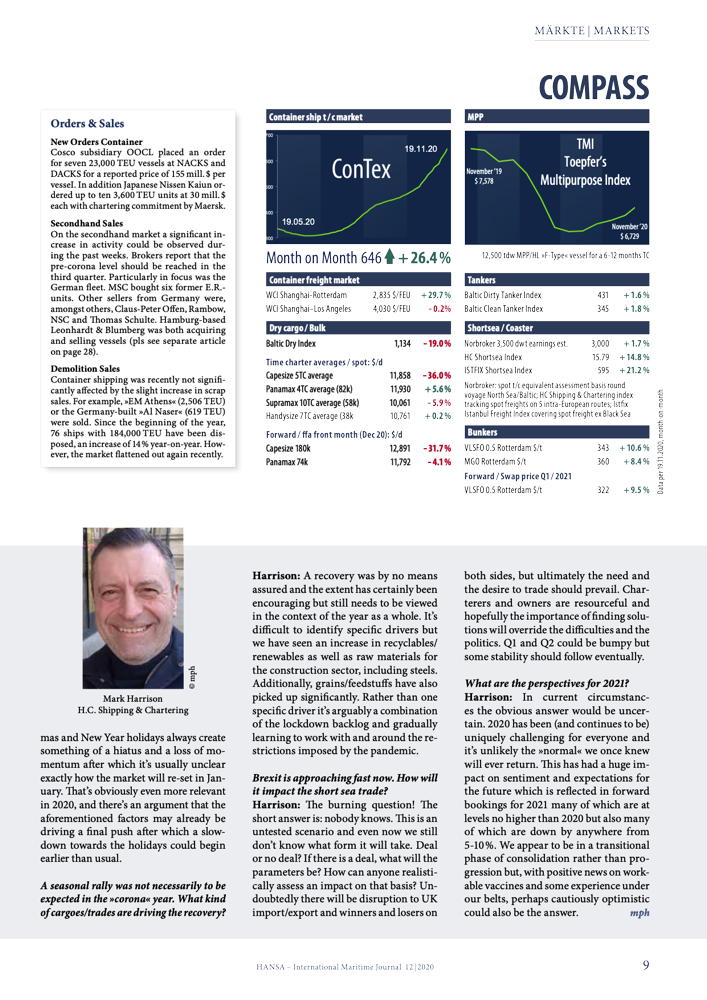Freight and charter rates continue rallying in sync as liner resources are stretched to the limit. Last feeders in Europe coming out of lay-up, writes Michael Hollmann
Sure enough, some of the increases in our market compass make you rub your eyes in disbelief. While daily life[ds_preview] and business activities in Europa are heavily constrained by second lock-downs, the rallye in container shipping continues as if there’s no tomorrow!
All the indications are that trade volumes have kept trending up during the past weeks after official data for September showed that traffic is firmly on the growth path again. According to CTS data, global export liftings during the third quarter expanded by 3.0% year-on-year after a -10.0% drop during the second quarter.
12% growth year-on-year
Momentum grew even stronger in September, with main lane trades recording +12.0% growth year-on-year. Unbelievable but true: data suggests that transpacific liftings from Asia to North America jumped by 31% in September while volumes ex Asia to Europe were up a more moderate but still very respectable +8.0% year-on-year. There is no clear-cut explanation but most analysts reckon that growth is powered by a combination of restocking across the economy and seasonal demand growth ahead of the Xmas shopping season.
Liftings data for October will only be released at the very end of November. But anecdotal reports from freight forwarding companies and current vessel activity suggest that the cargo boom continues. Based on idle fleet data from BRS Alphaliner, the world container ship fleet is basically fully employed. As per 9 November there were just 92 container ships »inactive« (1.5% of global TEU capacity), however most of these were already on standby for their next scheduled assignment, barred from trading due to financial/political reasons or in drydock for scrubber retrofits.
The number of tramp/non-operator-owned ships that are still available for charter is minimal although accurate data is hard to come by. Alphaliner counted 17 spot vessels worldwide as per mid-November while a leading Hamburg-based broker estimated 23 ships to be available within 14 days. With tonnage demand from operators still brisk, the logical result was a marked shift from »spot« to »forward« fixing. Panamax and even feeder 1,700 TEU ships were hired or extended for laycan dates as far as ahead as January.
Charter rates for the 1,100-4,250 TEU segments as captured by the New ConTex pushed up by more than 26% month-on-month. We cannot recall any such increase since inception of the New ConTex in 2007. In absolute terms, average charter rates are at their highest since 2008 now except for the feeder classes that were joining the rallye with some delay. Over the past 4 weeks, brokers reported gains from 500-1,500 $/day for feeder ships below 2.000 TEU to 5,000 $/day for standard panamax vessels.
Feeders heading out of lay-up
Even the Continent/Mediterranean feeder markets, encumbered by excess tonnage well into September, are now on a straight upward trend. Rates for ice-class 1,000 TEU vessels rose from mid 5,000’s to mid 6,000’s €/day within a couple of weeks, deals above 7,000 €/day are waiting to be confirmed.
In a sign of better times, the last few laid-up ships are now getting mobilised. Two of three Vega container ships laid up in Scotland are joining the trade again, with the 966 TEU »Vega Hercules« joining Unifeeder at 5,900 €/day for 5-7 months and sister Vega Scorpio heading to Flushing for a Continent/Caribs round trip under Seatrade charter at 7,950 $/day.
Meanwhile forwarders are reporting very tight slot capacity on trades ex Far East and even tighter empty container availability especially in South China. »We expect the market to remain strong until after Chinese New Year,« said Christoph Baumeister, Senior Trade Manager Asia/ISC-Europe at Flexport in Hamburg.
Recent spot rate increases were most spectacular on trades within Asia and from Far East to Europe, the Mediterranean, Australasia and South America. The combination of strong volumes and reduced productivity in terminal and landside operations due to anti-corona-measures also sparked some serious congestion, especially in UK ports, causing several ships to slip off schedule.
There has also been a speedy recovery in the European short sea market for dry/breakbulk cargoes since October (see interview with H.C.’s Mark Harrison). The HC freight index surged by 15% month-on-month while the Istfix vessel earnings index published in Istanbul is up 21%.
Orders & Sales
New Orders Container
Cosco subsidiary OOCL placed an order for seven 23,000TEU vessels at NACKS and DACKS for a reported price of 155mill. $ per vesseI. In addition Japanese Nissen Kaiun ordered up to ten 3,600TEU units at 30mill. $ each with chartering commitment by Maersk.
Secondhand Sales
On the secondhand market a significant increase in activity could be observed during the past weeks. Brokers report that the pre-corona level should be reached in the third quarter. Particularly in focus was the German fleet. MSC bought six former E.R.-units. Other sellers from Germany were, amongst others, Claus-Peter Offen, Rambow, NSC and Thomas Schulte. Hamburg-based Leonhardt & Blumberg was both acquiring and selling vessels (pls see separate article on page 28).
Demolition Sales
Container shipping was recently not significantly affected by the slight increase in scrap sales. For example, »EM Athens« (2,506TEU) or the Germany-built »Al Naser« (619TEU) were sold. Since the beginning of the year, 76 ships with 184,000TEU have been disposed, an increase of 14% year-on-year. However, the market flattened out again recently.
Michael Hollmann





















